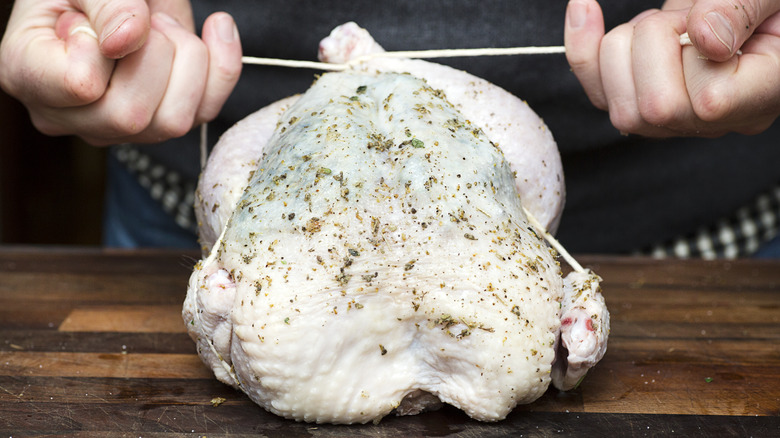Martha Stewart's Trussing Tip To Avoid Burnt Chicken Bits
Roasting a chicken is a skill most new cooks want to master. Nothing quite tops a juicy piece of meat shielded under a skin that has been cooked until it is golden brown and crispy. Many factors can influence the taste of your end product including how you prep your chicken. For example, whether you are using a dry or a wet brine, Bon Appétit notes, it will add an incredible depth of flavor to your bird. But you don't always have to brine your roast chicken.
Per The Spruce Eats, Ina Garten has a recipe for roasted chicken that replaces brining with a less time-intensive process of stuffing it with aromatics. And brining fans should not be skeptical — it produces "shatteringly crisp" skin and "tender" meat and Garten is not the only celebrity chef that favors this method. According to an Instagram post, Martha Stewart is also a fan of skipping the brine and using aromatics like lemon, garlic, seasonings, and rosemary to up the taste of her roast chicken. However, that's not all the glamorous lifestyle guru does when she makes this dinnertime staple.
Perhaps the secret to Stewart's famous roast chicken is her nifty trussing trick that will help you avoid burnt chicken bits.
Do this for a more even roast
What does it mean to truss a chicken? Instructables explains trussing a chicken simply means tying the legs and wings in a manner that will keep them close to the bird's body so it doesn't burn or dry out while it's roasting. Martha Stewart concurs and explains in an Instagram post that you want to tuck the wings behind the chicken's body or the wing tips will burn. This also will help it roast more evenly.
Stewart then states that you want to take your twine and center it around the neck bone and run it down the sides. Next, take the string up and over the legs and tie those drumsticks together. Easy — or at least Stewart makes it look so.
But what happens if you don't truss your chicken when you roast it? It definitely won't be perfect like Martha Stewart's. In fact, Fifteen Spatulas says if you don't tie up the legs, the cavity of the bird is left open and while the chicken cooks, hot air is able to freely enter and dry out the breast meat.

